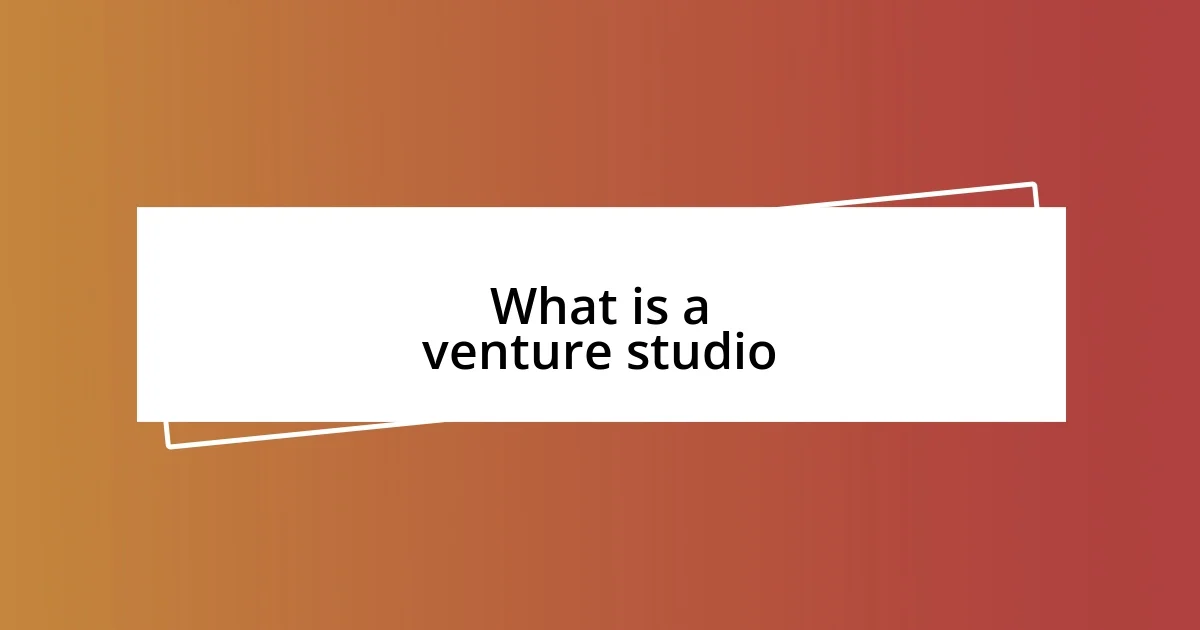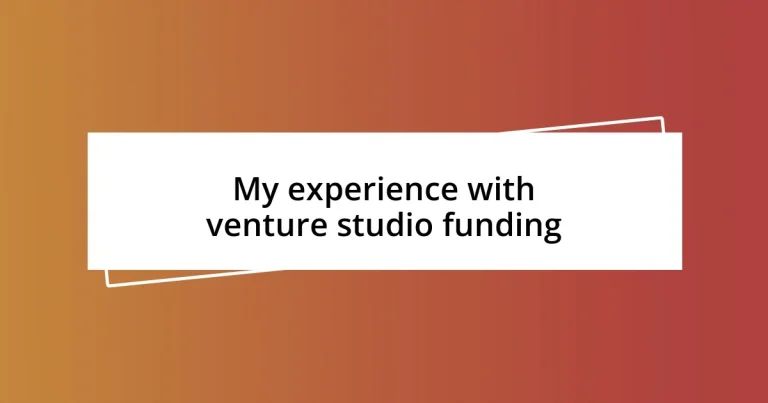Key takeaways:
- Venture studios provide a collaborative environment, combining ideation and resources to rapidly develop startups, offering hands-on support throughout the process.
- Challenges during funding include aligning investor expectations, competing for limited resources, and managing the emotional highs and lows of securing financial support.
- Key lessons learned include the importance of adaptability, the power of storytelling in pitching, and the value of building relationships with potential investors before seeking funding.

Understanding venture studio funding
Venture studio funding operates on a unique model that blends ideation, creation, and investment. It’s fascinating to think about how studios can rapidly develop multiple startups simultaneously, with a dedicated team focused on each venture. Have you ever wondered what it would be like to have a whole team of experts nurturing your idea from inception to launch? In my experience, this collaborative atmosphere fuels creativity and drives innovation.
What truly sets venture studios apart is their hands-on approach. I remember when I joined a venture studio; the level of support and guidance I received was incredible. From branding to coding, the access to resources was unparalleled. I often found myself collaborating with designers and strategists who challenged my thinking. This synergy is not just beneficial—it’s transformative, often turning abstract ideas into viable products in record time.
There’s also an emotional aspect to venture studio funding that is often overlooked. The exhilarating rush of seeing your vision come to life, backed by a dedicated team, is something I will never forget. It’s a unique blend of passion and pragmatism, where fear and excitement coexist as you navigate the startup landscape. Have you ever felt that blend of nerves and anticipation when launching something new? That’s a common feeling among entrepreneurs in this space, underscoring the dynamic nature of venture studio funding.

What is a venture studio
A venture studio, often referred to as a startup studio or venture builder, is an organization that creates new companies from scratch. Unlike traditional incubators or accelerators, venture studios are deeply involved in the entire process, from the initial idea to the actual launch. I still remember my first encounter with a venture studio; the atmosphere buzzed with excitement as entrepreneurs collaborated intensely around shared goals. The dedication of the team, who genuinely believed in nurturing innovative concepts, was palpable and infectious.
Here are some key features of venture studios:
- Idea Generation: They actively brainstorm and design new business ideas, often based on market needs.
- Resource Access: Studios provide access to resources like funding, mentorship, and technical expertise.
- Team Structure: Each venture typically has its own dedicated team, ensuring focused support throughout the development process.
- Risk Mitigation: By launching multiple ventures, studios diversify their risks and increase the chances of success for each project.
- Market Launch: They guide the startups through to product launch and initial market entry, often leveraging their networks for faster traction.
Having experienced the collective energy of a studio firsthand, I can say there’s something truly inspiring about collaborating with a group that shares a common purpose. The synergy between founders and teams fosters a sense of camaraderie that undoubtedly boosts creativity and problem-solving.

Challenges faced during funding
During the funding process, one of the most significant challenges I faced was navigating the complexities of investor expectations. Each investor had a different vision, and aligning those with our startup goals felt daunting at times. I remember a meeting where I presented our development timeline, and one investor questioned the feasibility of our projections. It forced me to confront the harsh reality that our timelines were perhaps overly optimistic. This experience taught me the importance of managing expectations upfront and being realistic about what can be achieved.
Another challenge that stands out is the competition for funding within the venture studio ecosystem. With many startups vying for the same financial support, I often felt like we were in a race against time. I vividly recall attending a pitch event, surrounded by other passionate entrepreneurs, and realizing there was so much talent in the room. It was both inspiring and intimidating. This atmosphere pushed me to refine our pitch continually and distinguish our unique value proposition clearly. I’ve learned that showcasing how your venture solves a specific problem or meets a market need is crucial in standing out.
Lastly, securing funding can sometimes feel like an emotional rollercoaster. I recall the day when we finally received a positive signal from a potential investor after weeks of uncertainty. The feeling was surreal, filled with excitement and relief. But that joy came with the understanding that this was just the beginning, and the journey ahead would come with its own set of hurdles. I’ve learned to embrace this emotional journey, recognizing that every setback can teach valuable lessons that ultimately contribute to success.
| Challenge | Description |
|---|---|
| Investor Expectations | Aligning investor visions with startup goals can create significant pressure. |
| Competition for Funding | Many startups compete for limited resources, necessitating a strong pitch to stand out. |
| Emotional Rollercoaster | The funding journey can evoke a mix of excitement and anxiety, impacting decision-making. |

Lessons learned from the experience
One significant lesson I learned was the importance of adaptability. Early on, I focused heavily on a rigid vision for our product, believing that sticking to the plan would lead us to success. However, as discussions with mentors and investors unfolded, it became clear that flexibility was key. I remember a moment where I had to pivot entirely based on feedback. It was uncomfortable at first, but that shift opened new doors, and I later realized that being open to change can dramatically shape the path to success.
Another insight I gained was the power of storytelling. Investors don’t just want cold, hard data; they want to connect emotionally with the venture. I vividly recall a pitch meeting where, instead of merely spitting out financial projections, I shared a personal story of how our product could impact someone’s life. That moment transformed the room’s energy, and it drove home the significance of our mission. Have you ever found that a simple narrative can bridge gaps that numbers alone cannot? It was a game-changer for my approach to funding conversations.
Lastly, I discovered the value of building relationships before seeking funding. In my early days, I underestimated the importance of forming bonds with potential investors. It wasn’t until I attended a casual networking event and shared coffee with a few folks that I realized how powerful those connections can be. A friendly chat led to introductions and eventual discussions about funding opportunities. I learned that taking the time to cultivate these relationships pays off; it made the funding process feel less transactional and more like a partnership. What if those informal connections lead to your next big break? In my experience, they very well might.














